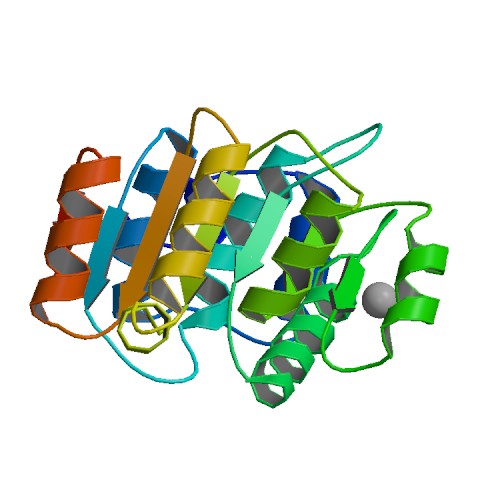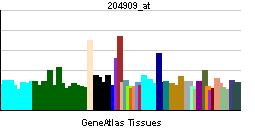DDX6
| DEAD (Asp-Glu-Ala-Asp) box polypeptide 6 | |||||||||||||
|---|---|---|---|---|---|---|---|---|---|---|---|---|---|
 PDB rendering based on 1vec. | |||||||||||||
| |||||||||||||
| Identifiers | |||||||||||||
| Symbols | DDX6 ; FLJ36338; HLR2; P54; RCK | ||||||||||||
| External IDs | Template:OMIM5 Template:MGI HomoloGene: 3238 | ||||||||||||
| |||||||||||||
| RNA expression pattern | |||||||||||||
 | |||||||||||||
| More reference expression data | |||||||||||||
| Orthologs | |||||||||||||
| Template:GNF Ortholog box | |||||||||||||
| Species | Human | Mouse | |||||||||||
| Entrez | n/a | n/a | |||||||||||
| Ensembl | n/a | n/a | |||||||||||
| UniProt | n/a | n/a | |||||||||||
| RefSeq (mRNA) | n/a | n/a | |||||||||||
| RefSeq (protein) | n/a | n/a | |||||||||||
| Location (UCSC) | n/a | n/a | |||||||||||
| PubMed search | n/a | n/a | |||||||||||
DEAD (Asp-Glu-Ala-Asp) box polypeptide 6, also known as DDX6, is a human gene.[1]
DEAD box proteins, characterized by the conserved motif Asp-Glu-Ala-Asp (DEAD), are putative RNA helicases. They are implicated in a number of cellular processes involving alteration of RNA secondary structure such as translation initiation, nuclear and mitochondrial splicing, and ribosome and spliceosome assembly. Based on their distribution patterns, some members of this family are believed to be involved in embryogenesis, spermatogenesis, and cellular growth and division. This gene encodes a DEAD box protein. It may contribute to the cell proliferation and carcinogenesis.[1]
References
Further reading
- Akao Y, Seto M, Yamamoto K; et al. (1992). "The RCK gene associated with t(11;14) translocation is distinct from the MLL/ALL-1 gene with t(4;11) and t(11;19) translocations". Cancer Res. 52 (21): 6083–7. PMID 1394235.
- Lu D, Yunis JJ (1992). "Cloning, expression and localization of an RNA helicase gene from a human lymphoid cell line with chromosomal breakpoint 11q23.3". Nucleic Acids Res. 20 (8): 1967–72. PMID 1579499.
- Akao Y, Marukawa O, Morikawa H; et al. (1995). "The rck/p54 candidate proto-oncogene product is a 54-kilodalton D-E-A-D box protein differentially expressed in human and mouse tissues". Cancer Res. 55 (15): 3444–9. PMID 7614484.
- Zhang WJ, Wu JY (1996). "Functional properties of p54, a novel SR protein active in constitutive and alternative splicing". Mol. Cell. Biol. 16 (10): 5400–8. PMID 8816452.
- Akiyama K, Akao Y, Yokoyama M; et al. (1999). "Expression of two dead box genes (DDX1 and DDX6) is independent of that of MYCN in human neuroblastoma cell lines". Biochem. Mol. Biol. Int. 47 (4): 563–8. PMID 10319407.
- Nakagawa Y, Morikawa H, Hirata I; et al. (1999). "Overexpression of rck/p54, a DEAD box protein, in human colorectal tumours". Br. J. Cancer. 80 (5–6): 914–7. doi:10.1038/sj.bjc.6690441. PMID 10360675.
- Smillie DA, Sommerville J (2002). "RNA helicase p54 (DDX6) is a shuttling protein involved in nuclear assembly of stored mRNP particles". J. Cell. Sci. 115 (Pt 2): 395–407. PMID 11839790.
- Strausberg RL, Feingold EA, Grouse LH; et al. (2003). "Generation and initial analysis of more than 15,000 full-length human and mouse cDNA sequences". Proc. Natl. Acad. Sci. U.S.A. 99 (26): 16899–903. doi:10.1073/pnas.242603899. PMID 12477932.
- Miyaji K, Nakagawa Y, Matsumoto K; et al. (2003). "Overexpression of a DEAD box/RNA helicase protein, rck/p54, in human hepatocytes from patients with hepatitis C virus-related chronic hepatitis and its implication in hepatocellular carcinogenesis". J. Viral Hepat. 10 (4): 241–8. PMID 12823589.
- Matsui T, Hogetsu K, Akao Y; et al. (2004). "Crystallization and X-ray analysis of the N-terminal core domain of a tumour-associated human DEAD-box RNA helicase, rck/p54". Acta Crystallogr. D Biol. Crystallogr. 60 (Pt 1): 156–9. PMID 14684915.
- Ota T, Suzuki Y, Nishikawa T; et al. (2004). "Complete sequencing and characterization of 21,243 full-length human cDNAs". Nat. Genet. 36 (1): 40–5. doi:10.1038/ng1285. PMID 14702039.
- Gerhard DS, Wagner L, Feingold EA; et al. (2004). "The status, quality, and expansion of the NIH full-length cDNA project: the Mammalian Gene Collection (MGC)". Genome Res. 14 (10B): 2121–7. doi:10.1101/gr.2596504. PMID 15489334.
- Fenger-Grøn M, Fillman C, Norrild B, Lykke-Andersen J (2006). "Multiple processing body factors and the ARE binding protein TTP activate mRNA decapping". Mol. Cell. 20 (6): 905–15. doi:10.1016/j.molcel.2005.10.031. PMID 16364915.
- Matsui T, Hogetsu K, Usukura J; et al. (2006). "Structural insight of human DEAD-box protein rck/p54 into its substrate recognition with conformational changes". Genes Cells. 11 (4): 439–52. doi:10.1111/j.1365-2443.2006.00951.x. PMID 16611246.
- Wichroski MJ, Robb GB, Rana TM (2006). "Human retroviral host restriction factors APOBEC3G and APOBEC3F localize to mRNA processing bodies". PLoS Pathog. 2 (5): e41. doi:10.1371/journal.ppat.0020041. PMID 16699599.
- Chu CY, Rana TM (2006). "Translation repression in human cells by microRNA-induced gene silencing requires RCK/p54". PLoS Biol. 4 (7): e210. doi:10.1371/journal.pbio.0040210. PMID 16756390.
- Ewing RM, Chu P, Elisma F; et al. (2007). "Large-scale mapping of human protein-protein interactions by mass spectrometry". Mol. Syst. Biol. 3: 89. doi:10.1038/msb4100134. PMID 17353931.
- Nonhoff U, Ralser M, Welzel F; et al. (2007). "Ataxin-2 interacts with the DEAD/H-box RNA helicase DDX6 and interferes with P-bodies and stress granules". Mol. Biol. Cell. 18 (4): 1385–96. doi:10.1091/mbc.E06-12-1120. PMID 17392519.
| This protein-related article is a stub. You can help Wikipedia by expanding it. |